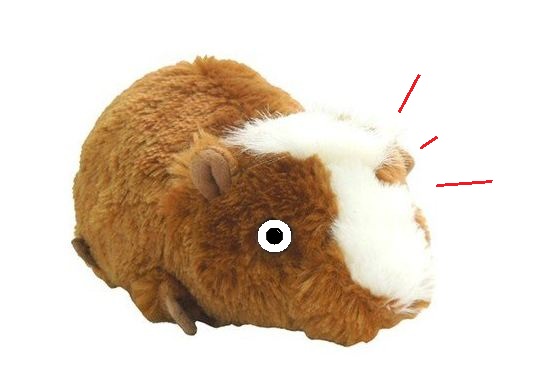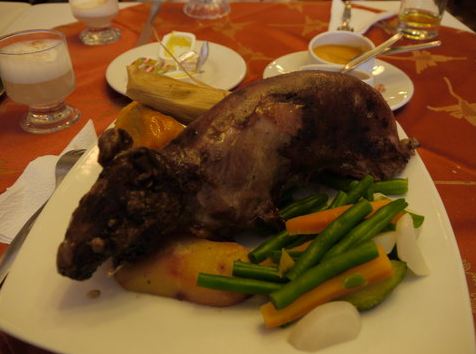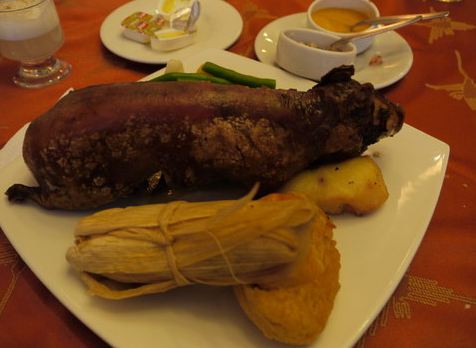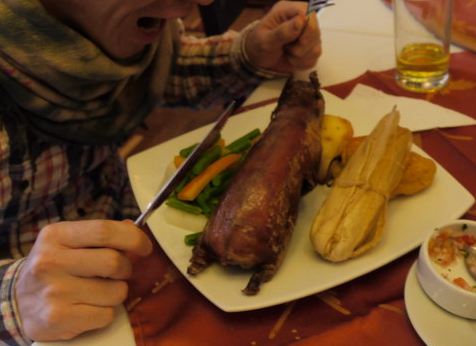
First of all, let it be known that I like meat.
Chicken, beef, turkey, pork; it’s all good. While I’m by no means shy of vegetables or fish, I love to cook, and there are few meals that I enjoy more than a good chicken curry, a classic beef lasagne, home-made hamburgers, or a nice, simple, piece of medium-rare steak.
But when food comes to me with its face still intact, I’m not so happy.
In the past, a few vegetarians have told me “If you couldn’t bring yourself to kill and prepare meat then you shouldn’t eat it.” Personally, I wouldn’t care to chop down a tree and painstakingly make individual sheets of paper, either, but I’m still happy to use the stuff on a daily basis, but even if it makes me a wimp, or immoral, I’m still happy to eat meat so long as I don’t have to get my hands dirty. So long as there are no eyes looking up at me from the plate, and preferably nothing that screams “I used to be alive, you know!”, I’m happy to tuck in.
So when I came across ITMedia writer Wataru Kato’s first-hand experience of eating a whole, roasted rodent, it was with both a curious mind and a slightly churning stomach that I read on, wondering whether, were I presented with the same dish, I could bring myself to eat it, let alone sit with it staring back at me.
The rodent in question is a specially bred Peruvian guinea pig, quite far removed from the kind of creature you might spot scuttling down a dark alley or up a drain pipe.
Nevertheless, we recommend tackling this particular story after you’ve finished your next meal.
Hold on to your lunch…
The Peruvian guinea pig is reported to be both low in cholesterol and a great source of protein, making it a comparatively healthy meat. The animals are clean, docile, and have been eaten in Peru for hundreds of years, with the average guinea pig being much bigger than those most people are used to keeping as pets, thanks to their daily diet of food scraps from the household by which they are kept.
During a trip to Peru, Wataru sat down to try the country’s national dish, and documented the entire process for us all to see.
Imagine, ladies and gents, being presented with this…
Feeling queasy yet?
Guinea pigs are prepared very similarly to other meats, with the hair removed immediately after it has been killed, then the internal organs (shall we say “giblets” to save our stomachs?) carefully removed before the entire thing is immersed in boiling hot water to cook through. Finally, the guinea pig is roasted along with vegetables like carrots, beans and peppers before being generously seasoned and plonked down on the plate… whole.
As a man who struggles with any meat that still resembles its former, living, self, and prefers not to eat even chicken from the bone, I’m not sure I could handle this particular dish, healthy or otherwise…
Try as I might to keep an open mind, that looks awfully like a roasted rat to me, and brings back memories of the post-apocalyptic adventure game Fallout, with its “squirrel bits” snacks and mutated cockroach meat… <shudder>
But how did the brave diner get on with the dish?
“It’s surprisingly like chicken;” (Isn’t everything?) “It’s a firm, sinewy meat, and didn’t have a particularly strong smell. Honestly, I think if they couldn’t see what they were eating, most people would believe this to be chicken,” said Wataru. I don’t know about you guys, but I’m happy to take his word for it…
“Though I had to be careful of the little bones while eating, there was plenty of meat; so much, in fact, that it would probably be enough for two people to share.”
Hmmm…I’m still not convinced. Roasted guinea pig might not make the most romantic meal to share. I mean, the arguments over who gets to eat the head alone would be terrible…
But Wataru definitely earned his pay here, and, having picked the bones clean, assure us that the dish should not be avoided based on simple preconceptions.
“There must be food that we Japanese eat on a regular basis that people in other countries would be surprised at, just as how we couldn’t believe our eyes when someone places a roasted guinea pig on the table,” he quite rightly suggest.
Since moving to Japan some six years ago, I can honestly say that I’ve become a much less fussy eater, and now regularly eat food that I might never have dared touch before. Raw squid and octopus? No problem. Deep-fried chicken cartilage? Sure. Fermented soy beans? Why not. Stir-fried tanuki tail…? OK, so the last one is a dirty, filthy lie, but you get the point…
Food that one person may think of as completely disgusting might be as normal as a ham and cheese sandwich to someone else. It’s all about perceptions and exposure.
During a 12-month Japanese language course I took last year, I had the pleasure of meeting people from all over the world, sharing personal experiences of life in Japan, learning a lot about other cultures, customs and ways of thinking. Because we were all students of the Japanese language, we found ourselves in the unique position of having a room full of people of from all over the globe, but whose shared language was the same, and were able to communicate more or less freely. Stereotypes were challenged, questions were asked and myths dispelled on a near daily basis.
One day, turning to the Korean girl sitting next to me, I broached the subject of Koreans eating animals that we in the west would never dream of, and asked whether it was true, as I was once informed by an adamant Japanese friend, that Koreans eat both cat and dog meat.
Being a cat owner since I was a just a child, the thought of anyone eating anything that resembled one of my furry little pals shocked me, but I tried to phrase the question as neutrally as possible:
“I once heard that some Koreans actually eat cat and dog meat. That’s just a myth, though, right?”
The girl looked at me with an expression of abject horror. “Cat meat!? Oh my goodness no! How awful! Of course we don’t.”
Realising how stupid it sounded, I apologising for asking such a ridiculous question, but then realised that she hadn’t mentioned dogs in her answer… So, was that part of the myth, too?
“Oh, yeah, we eat dog,” she replied as calmly as if I’d asked her whether her people ate rice.
Culture plays an enormous role in our perceptions and established ideas. There are people out there who wouldn’t touch pork, whereas others will happily fry up a few slices of bacon but positively retch at the notion of eating frogs’ legs or snails. Similarly, to my Korean friend, the idea of eating a cat was hideous, but tucking in to a little canine meat didn’t phrase her in the slightest.
Maybe it’s about time we sat down to a roasted guinea pig and opened our minds a little…?
Enjoy your dinner, guys.
Source / images : IT Media Netorabo Title image: Yoshitoku Toys edited by RocketNews24





 Guinea pigs in Tokyo zoo get pampered in the cutest video of 2020
Guinea pigs in Tokyo zoo get pampered in the cutest video of 2020 【Monday Kickstart】Guinea pigs heading home for the night are delightfully darling
【Monday Kickstart】Guinea pigs heading home for the night are delightfully darling Two guinea pigs accidentally find love sharing a snack on November 11th “Pocky Day” 【Video】
Two guinea pigs accidentally find love sharing a snack on November 11th “Pocky Day” 【Video】 Steamy Heinz Japan commercials urge married women to have affairs with handsome pig【Videos】
Steamy Heinz Japan commercials urge married women to have affairs with handsome pig【Videos】 Packs of pig vaginas for sale at Japanese market disgust/intrigue Internet【Photos】
Packs of pig vaginas for sale at Japanese market disgust/intrigue Internet【Photos】 Hello Kitty Choco Egg figures are an adorable trip through three periods of Japanese pop culture【Pics】
Hello Kitty Choco Egg figures are an adorable trip through three periods of Japanese pop culture【Pics】 Hayao Miyazaki says Happy New Year to Studio Ghibli fans with new art for Year of the Horse
Hayao Miyazaki says Happy New Year to Studio Ghibli fans with new art for Year of the Horse Starbucks Japan ready to get Year of the Horse started with adorable drinkware and plushies【Pics】
Starbucks Japan ready to get Year of the Horse started with adorable drinkware and plushies【Pics】 Attack on Titan x Uniqlo pairing unleashes a colossal collaboration on the world
Attack on Titan x Uniqlo pairing unleashes a colossal collaboration on the world Man Frames Octopus for Murder or Vice-Versa, Trial Ongoing in South Korea
Man Frames Octopus for Murder or Vice-Versa, Trial Ongoing in South Korea Japanese thug wear from Birth Japan perfect for those breaking bad next year
Japanese thug wear from Birth Japan perfect for those breaking bad next year Pizza Hut Japan’s hot lucky bags are perfect for a New Year’s pizza party
Pizza Hut Japan’s hot lucky bags are perfect for a New Year’s pizza party Japan has a special foil for roasting sweet potatoes at home, and it’s like having a time machine
Japan has a special foil for roasting sweet potatoes at home, and it’s like having a time machine Alcohol Made with Fermented Wasps Gives New Meaning to the Phrase “Get Your Buzz On”
Alcohol Made with Fermented Wasps Gives New Meaning to the Phrase “Get Your Buzz On” Starbucks Japan unveils new Sakura Frappuccino for cherry blossom season 2025
Starbucks Japan unveils new Sakura Frappuccino for cherry blossom season 2025 7-Eleven Japan’s ramen-cooking robot whipped us up a bowl of noodles【Taste test】
7-Eleven Japan’s ramen-cooking robot whipped us up a bowl of noodles【Taste test】 Cyberpunk anime meets traditional culture in Ghost in the Shell gold leaf Japanese changing screens
Cyberpunk anime meets traditional culture in Ghost in the Shell gold leaf Japanese changing screens 7 great places to see Mt. Fuji from without having to climb it
7 great places to see Mt. Fuji from without having to climb it Japan’s otoshidama tradition of giving kids money at New Year’s gets a social welfare upgrade
Japan’s otoshidama tradition of giving kids money at New Year’s gets a social welfare upgrade We found possibly the quietest Japanese-style hotel in Tokyo’s bustling Shinjuku district
We found possibly the quietest Japanese-style hotel in Tokyo’s bustling Shinjuku district Lacquerware supplier to emperor of Japan and Pokémon team up for new tableware
Lacquerware supplier to emperor of Japan and Pokémon team up for new tableware Sumo Sanrio! Hello Kitty and pals team up with Japan Sumo Association for new merch【Pics】
Sumo Sanrio! Hello Kitty and pals team up with Japan Sumo Association for new merch【Pics】 Can a dirty butthole make you filthy rich in Japan? We’re starting a New Year’s lottery experiment
Can a dirty butthole make you filthy rich in Japan? We’re starting a New Year’s lottery experiment 7-Eleven Japan starts new temporary luggage storage service in over 300 branches
7-Eleven Japan starts new temporary luggage storage service in over 300 branches Disillusionment at Tsukiji’s tourist-target prices led us to a great ramen restaurant in Tokyo
Disillusionment at Tsukiji’s tourist-target prices led us to a great ramen restaurant in Tokyo Starbucks teams up with 166-year-old Kyoto doll maker for Year of the Horse decorations【Photos】
Starbucks teams up with 166-year-old Kyoto doll maker for Year of the Horse decorations【Photos】 Tokyo considering law requiring more trash cans following litter increase in heavily touristed area
Tokyo considering law requiring more trash cans following litter increase in heavily touristed area Tokyo’s Tsukiji sushi neighborhood asks tour groups to stay away for the rest of the month
Tokyo’s Tsukiji sushi neighborhood asks tour groups to stay away for the rest of the month Nintendo’s Kirby now delivering orders at Kura Sushi restaurants, but not in Japan
Nintendo’s Kirby now delivering orders at Kura Sushi restaurants, but not in Japan Tokyo event lets you travel back in time, for free, to celebrate 100 years since Showa era start
Tokyo event lets you travel back in time, for free, to celebrate 100 years since Showa era start Sanrio theme park in Japan announces plans to expand into a Sanrio resort
Sanrio theme park in Japan announces plans to expand into a Sanrio resort Japan may add Japanese language proficiency, lifestyle classes to permanent foreign resident requirements
Japan may add Japanese language proficiency, lifestyle classes to permanent foreign resident requirements Survey asks foreign tourists what bothered them in Japan, more than half gave same answer
Survey asks foreign tourists what bothered them in Japan, more than half gave same answer Japan’s human washing machines will go on sale to general public, demos to be held in Tokyo
Japan’s human washing machines will go on sale to general public, demos to be held in Tokyo Japan’s deadliest food claims more victims, but why do people keep eating it for New Year’s?
Japan’s deadliest food claims more victims, but why do people keep eating it for New Year’s? We deeply regret going into this tunnel on our walk in the mountains of Japan
We deeply regret going into this tunnel on our walk in the mountains of Japan Studio Ghibli releases Kodama forest spirits from Princess Mononoke to light up your home
Studio Ghibli releases Kodama forest spirits from Princess Mononoke to light up your home Major Japanese hotel chain says reservations via overseas booking sites may not be valid
Major Japanese hotel chain says reservations via overseas booking sites may not be valid Put sesame oil in your coffee? Japanese maker says it’s the best way to start your day【Taste test】
Put sesame oil in your coffee? Japanese maker says it’s the best way to start your day【Taste test】 No more using real katana for tourism activities, Japan’s National Police Agency says
No more using real katana for tourism activities, Japan’s National Police Agency says Starbucks Japan reveals new sakura drinkware collection, inspired by evening cherry blossoms
Starbucks Japan reveals new sakura drinkware collection, inspired by evening cherry blossoms Updated cherry blossom forecast shows extra-long sakura season for Japan this year
Updated cherry blossom forecast shows extra-long sakura season for Japan this year This Japanese pork is now being sold with its very own sexy manga series: The Four Men of Pigs
This Japanese pork is now being sold with its very own sexy manga series: The Four Men of Pigs Sandwiches fit for a sumo served up in Osaka【Taste Test】
Sandwiches fit for a sumo served up in Osaka【Taste Test】 Scandal rocks McDonald’s Kanto-Kansai burger election, Tokyo Roast Beef Burger caught lying to voters
Scandal rocks McDonald’s Kanto-Kansai burger election, Tokyo Roast Beef Burger caught lying to voters How do people in Japan feel about eating whale? We asked five people for their opinions
How do people in Japan feel about eating whale? We asked five people for their opinions How’s it feel to eat KFC in front of a Final Fantasy Chocobo, and how would Chocobos feel about it?
How’s it feel to eat KFC in front of a Final Fantasy Chocobo, and how would Chocobos feel about it? Japan asks if bananas with Sprite will make you puke, Brazilian comedians answer 【Video】
Japan asks if bananas with Sprite will make you puke, Brazilian comedians answer 【Video】 Top Asian delicacies that many consider kind of gross
Top Asian delicacies that many consider kind of gross Japan’s Domino’s Pizza commercial features chickens, pigs, and a huge serving of weird 【Video】
Japan’s Domino’s Pizza commercial features chickens, pigs, and a huge serving of weird 【Video】 Clever naming has New York diners raving about Japanese-style cod roe and pigs’ feet
Clever naming has New York diners raving about Japanese-style cod roe and pigs’ feet Boys love manga pork: BL anime characters now in the chilled meat section
Boys love manga pork: BL anime characters now in the chilled meat section Our Japanese reporter asks for some authentic American food…but does he enjoy the experience?
Our Japanese reporter asks for some authentic American food…but does he enjoy the experience? Mr. Sato seeks meaty, booze-soaked redemption at Lopia【Japan’s Best Home Senbero】
Mr. Sato seeks meaty, booze-soaked redemption at Lopia【Japan’s Best Home Senbero】 Food Triathlon eating challenge accepting all comers at Yamaguchi restaurant this autumn
Food Triathlon eating challenge accepting all comers at Yamaguchi restaurant this autumn Japanese student reacts to UK food: “How did One Direction survive growing up in this country?”
Japanese student reacts to UK food: “How did One Direction survive growing up in this country?”
Leave a Reply